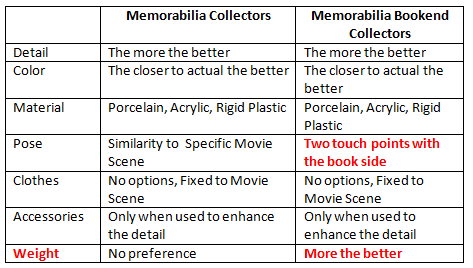Val Workman
The opinions expressed by the bloggers below and those providing comments are theirs alone, and do not necessarily reflect the opinions of Ryma Technology Solutions. As they say, you can't innovate without breaking a few eggs...
Market Matrix & Product Features
The picture below is of two figurines I own. So why do I own these two guys? In fact, why do I own over fifty others? I wish the makers of these figurines would've asked me a long time ago.

But before I address this customer interview, I'd like to establish a little common background if I can. What's the traditional way of developing product features, in this case features for the figurine? Normally we'd say in response to some market demand.
I don't even know the troll looking figurine's name, but I believe he was in some of the Harry Potter's movies (it's my wife's collection). The market place was or is hungry for Harry Potter memorabilia, so there he is, in sack cloth and everything.
Of course everyone knows Jessica Rabbit from "Who Framed Roger Rabbit?". My question is, what determined her features. Yes, I've heard sex sells, but that's not what I mean. Here, let's take a look at a market matrix used in market segmentation.
In this matrix, features are rows and targeted personas meant to consume those features are the columns. By definition, the intersection between the rows and columns are a market segment. In this example, I've placed persona values relevant to the feature in the intersection.

Targeting both of these market segments would be difficult, because of their sometimes opposite values. Normally this isn’t tried, but compromises could be found by decomposing the two personas into sub-categories with common values. The question would then be what is larger, the joint 'compromised persona' or either of the single segments by themselves. Maybe a segment of similar values could be carved out of one to increase the size of the other.
Besides creating compromised segments, there is another way to generate product features that increase market access. This involves interviewing representatives of the personas, and asking them what they use your product for, and what they value.
Let's say the product management team of 'Jessica Rabbit' interviewed me. If they had, they'd find we use the figurines as bookends to video cases. We use them to represent different movie genre in our movie collection. If they took that information back to their market matrix, this is what they'd see.

In this case, by interviewing the customer, they were able to refine one feature 'pose' probably as a PERFORMANCE requirement to increase perceived value, and add an additional feature 'Weight' that they didn't realize had any impact on market value. Now you can't say that in this case the interviews created a new market segment, although I've seen that done; but the interviews resulted in modifying their product feature set to better serve a small market segment within the larger. By doing so, they were able to increase their competitive advantage with a better set of features and requirements.
When considering customer interviews, it can be helpful to use the market matrix in both forming interview questions, and analyzing the results afterward.









Camilla's suits and dresses-with-jackets were often in dark colors and the opposite of flashy. But she wore a raspberry-pink suit the first day in New York